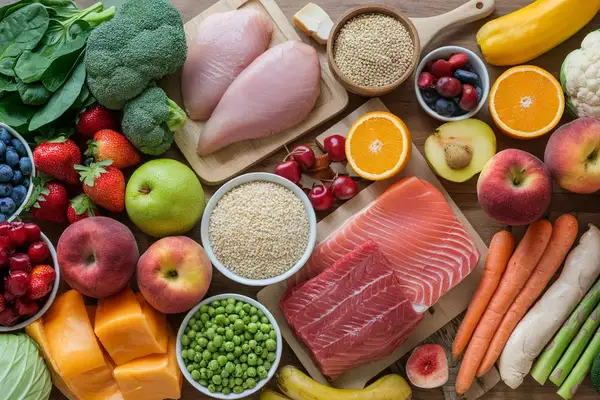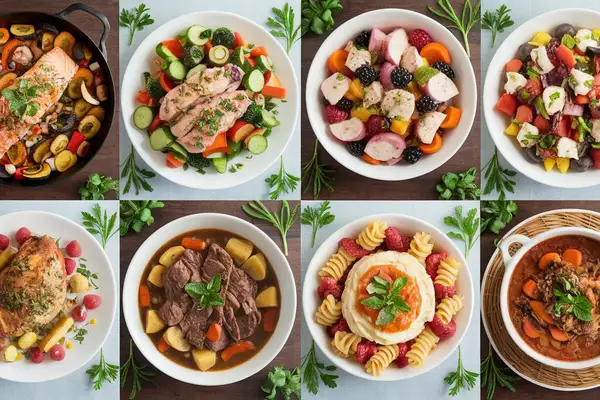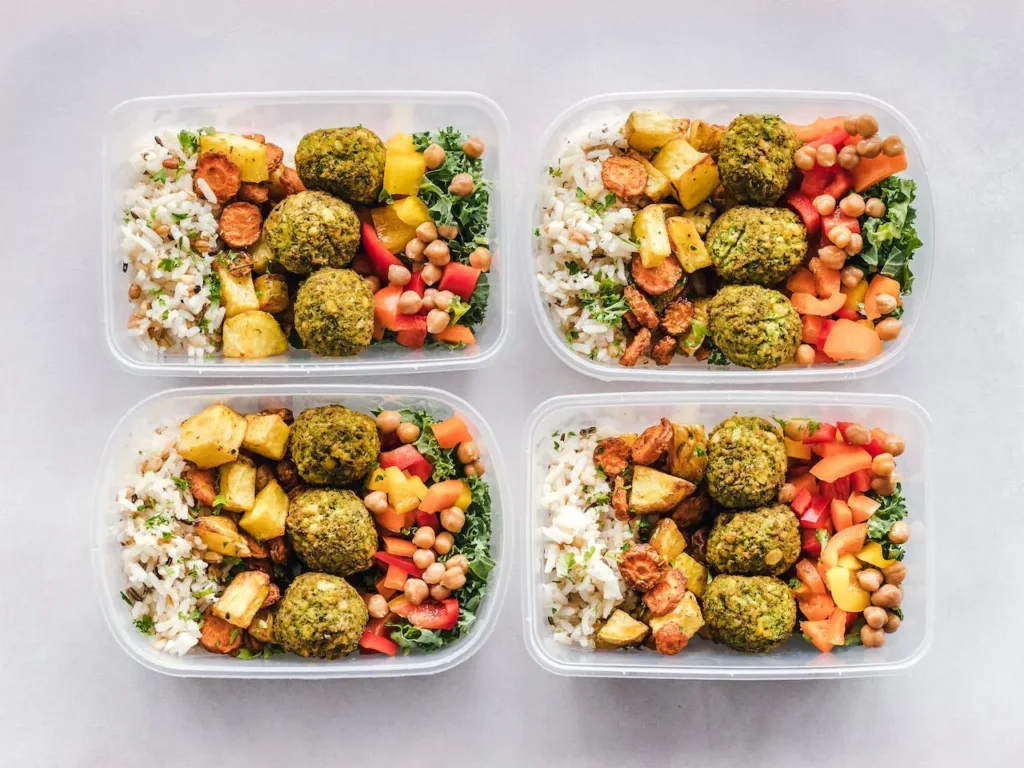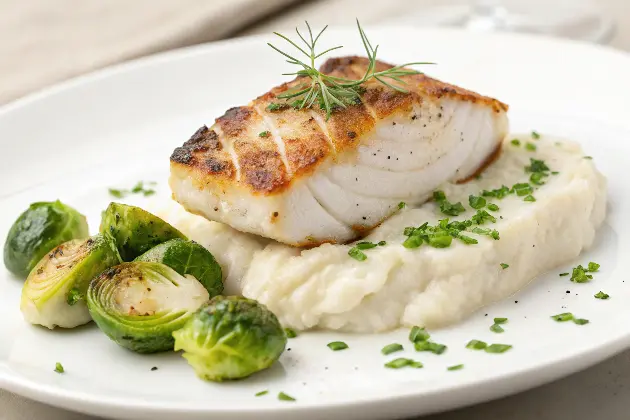Free 7 Day Clean Eating Meal Plan For Beginners
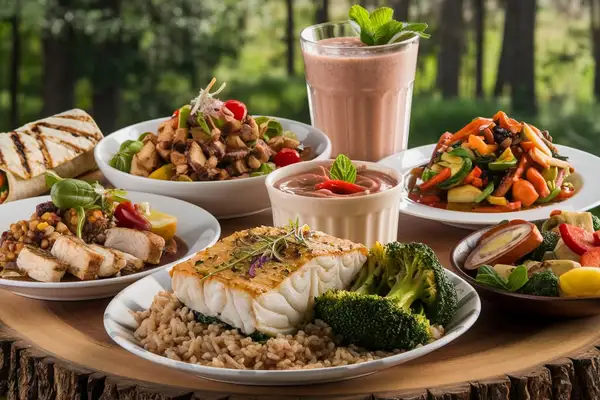
This post may contain affiliate links, meaning I may earn a commission if you make a purchase, at no extra cost to you. I only recommend products I trust. Thank you for your support.
Are you looking to reset your eating habits and embrace a healthier lifestyle?
A 7 day clean eating meal plan might be just what you need to kickstart your journey towards better nutrition and overall wellness.
Clean eating is more than just a diet; it’s a lifestyle that focuses on whole, unprocessed foods that nourish your body.
In this comprehensive guide, we’ll explore what clean eating is all about, provide you with a detailed clean eating diet plan, and share some delicious clean eating recipes to get you started.
What is Clean Eating?
Clean eating is all about consuming foods in their most natural state or as close to it as possible.
This means choosing whole foods like fruits, vegetables, lean proteins, whole grains, and healthy fats, while avoiding processed foods, added sugars, and artificial ingredients.
The goal is to nourish your body with nutrient-dense foods that fuel your energy levels, support your overall health, and help you feel your best.
Clean eating is not about restriction or deprivation, but rather making mindful choices about what you put on your plate.
Key principles of clean eating include:
- Choosing whole foods over processed options
- Limiting added sugars and artificial ingredients
- Emphasizing fruits, vegetables, whole grains, and lean proteins
- Cooking meals at home more often
Clean Eating Food List
To help you stock your kitchen for clean eating success, here’s a basic clean eating food list:
Proteins:
- Chicken breast
- Turkey
- Lean beef
- Fish (salmon, cod, tuna)
- Eggs
- Tofu
- Tempeh
- Legumes (beans, lentils, chickpeas)
Fruits:
- Apples
- Berries (strawberries, blueberries, raspberries)
- Bananas
- Oranges
- Pears
- Grapes
- Melons
Vegetables:
- Leafy greens (spinach, kale, lettuce)
- Broccoli
- Cauliflower
- Bell peppers
- Carrots
- Cucumbers
- Tomatoes
- Zucchini
Whole Grains:
- Brown rice
- Quinoa
- Oats
- Whole grain bread
- Whole wheat pasta
Healthy Fats:
- Avocado
- Nuts (almonds, walnuts, cashews)
- Seeds (chia, flax, pumpkin)
- Olive oil
- Coconut oil
Dairy Alternatives:
- Greek yogurt
- Almond milk
- Coconut milk
- Cheese (in moderation)
Foods to Avoid While Clean Eating
Here’s a list of foods you should generally avoid or limit when following a clean eating lifestyle:
- Processed foods: These include packaged snacks, frozen meals, and convenience foods that often contain artificial ingredients and preservatives.
- Refined grains: White bread, white pasta, and white rice are stripped of their nutrients and fiber. Opt for whole grains instead.
- Added sugars: Avoid foods with high amounts of added sugars, such as sodas, candies, condiments such as ketchup, and many breakfast cereals.
- Artificial sweeteners: While they may be calorie-free, artificial sweeteners are not considered “clean” and should be avoided.
- Trans fats: Found in many fried foods, baked goods, and some margarines, trans fats are unhealthy and should be eliminated from your diet.
- Processed meats: Foods like hot dogs, bacon, and deli meats often contain preservatives and additives.
- High-sodium foods: Many packaged and restaurant foods are high in sodium. Look for low-sodium options or prepare meals at home.
- Alcohol: While moderate consumption might be okay for some, alcohol is generally not considered part of a clean eating plan.
- Artificial colors and flavors: These are often found in processed foods and should be avoided.
- Refined vegetable oils: Oils like soybean, corn, and canola are highly processed and may contain GMOs.
7 Day Clean Eating Meal Plan for Beginners
This 7 day clean eating meal plan offers a balanced and nutritious approach to your daily meals, featuring a variety of clean eating recipes that are simple, delicious, and packed with wholesome ingredients.
This clean eating diet plan is designed to be flexible, so feel free to adjust portion sizes or swap ingredients to suit your preferences.
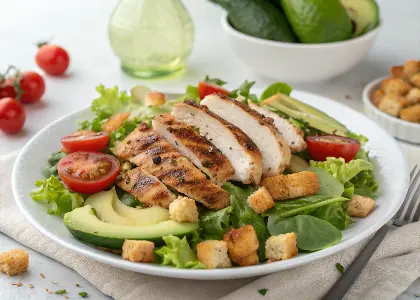
Day 1
Breakfast:
- Overnight Oats: Mix rolled oats, almond milk, chia seeds, and fresh berries in a jar and refrigerate overnight. (1/2 cup rolled oats, 1 cup almond milk, 1 tbsp chia seeds, 1/2 cup fresh berries)
Lunch:
- Grilled Chicken Salad: Toss grilled chicken breast with mixed greens, cherry tomatoes, cucumbers, and a lemon vinaigrette. (4 oz grilled chicken breast, 2 cups mixed greens, 1/2 cup cherry tomatoes, 1/2 cup cucumber slices, 1 tbsp lemon vinaigrette)
Dinner:
- Baked Salmon with Quinoa: Serve baked salmon with a side of quinoa and steamed broccoli. (6 oz baked salmon, 1/2 cup cooked quinoa, 1 cup steamed broccoli)
Snacks:
- Apple Slices with Almond Butter: Spread almond butter on fresh apple slices. (1 apple, 2 tbsp almond butter)
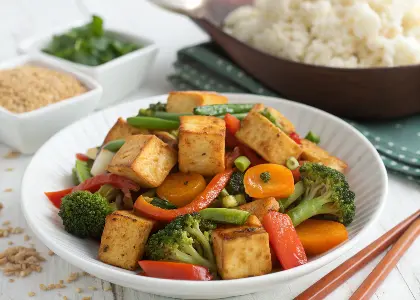
Day 2
Breakfast:
- Greek Yogurt Parfait: Layer Greek yogurt with fresh berries, honey, and granola. (1 cup Greek yogurt, 1/2 cup fresh berries, 1 tbsp honey, 1/4 cup granola)
Lunch:
- Turkey and Avocado Wrap: Wrap sliced turkey and avocado in a whole grain tortilla with spinach and tomato. (4 oz sliced turkey, 1/2 avocado, 1 whole grain tortilla, 1 cup spinach, 1/2 tomato)
Dinner:
- Stir-Fried Tofu and Vegetables: Stir-fry tofu with bell peppers, broccoli, and snap peas in olive oil with soy sauce. (1/2 block tofu, 1/2 cup bell peppers, 1 cup broccoli, 1/2 cup snap peas, 1 tbsp olive oil, 1 tbsp soy sauce)
Snacks:
- Carrot Sticks with Hummus: Dip carrot sticks in hummus for a crunchy snack. (1 cup carrot sticks, 1/4 cup hummus)
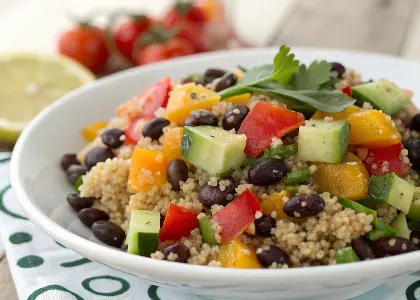
Day 3
Breakfast:
- Smoothie Bowl: Blend spinach, banana, almond milk, and protein powder, and top with granola and chia seeds. (1 cup spinach, 1 banana, 1 cup almond milk, 1 scoop protein powder, 1/4 cup granola, 1 tbsp chia seeds)
Lunch:
- Quinoa and Black Bean Bowl: Combine cooked quinoa with black beans, corn, diced tomatoes, and avocado. (1/2 cup cooked quinoa, 1/2 cup black beans, 1/4 cup corn, 1/2 cup diced tomatoes, 1/2 avocado)
Dinner:
- Grilled Shrimp Skewers: Serve grilled shrimp skewers with a side of brown rice and steamed asparagus. (6 oz grilled shrimp, 1/2 cup brown rice, 1 cup steamed asparagus)
Snacks:
- Mixed Nuts: A handful of almonds, walnuts, and cashews. (1/4 cup mixed nuts)
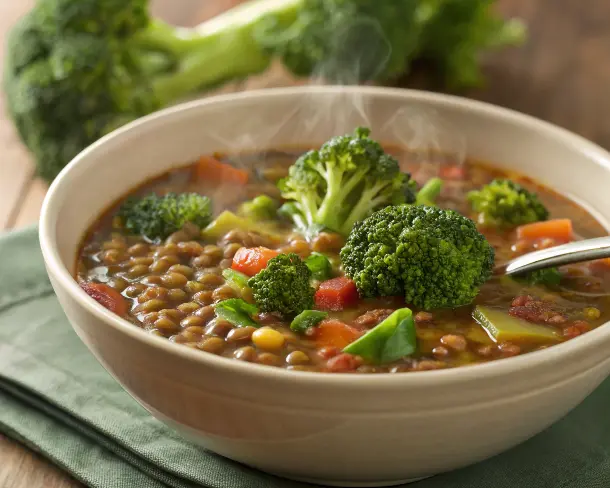
Day 4
Breakfast:
- Avocado Toast: Spread mashed avocado on whole grain toast and top with a poached egg. (1/2 avocado, 1 slice whole grain toast, 1 poached egg)
Lunch:
- Lentil Soup with Steamed Broccoli: Enjoy a hearty lentil soup with carrots, celery, and onions with steamed broccoli. (1 cup lentils, 1/2 cup carrots, 1/2 cup celery, 1/2 cup onions, 1 cup of broccoli)
Dinner:
- Baked Chicken and Sweet Potatoes: Serve baked chicken breast with roasted sweet potatoes and green beans. (6 oz baked chicken breast, 1 cup roasted sweet potatoes, 1 cup green beans)
Snacks:
- Cucumber Slices with Hummus: Dip cucumber slices in hummus. (1 cup cucumber slices, 1/4 cup hummus)
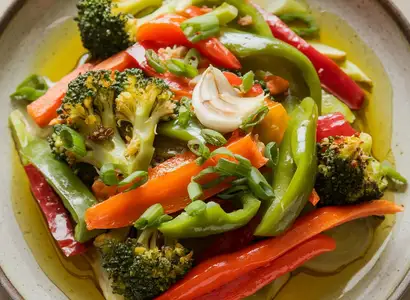
Day 5
Breakfast:
- Berry Smoothie: Blend mixed berries with almond milk, spinach, and chia seeds. (1 cup mixed berries, 1 cup almond milk, 1 cup spinach, 1 tbsp chia seeds)
Lunch:
- Chicken and Quinoa Salad: Mix grilled chicken with cooked quinoa, cherry tomatoes, cucumbers, and feta cheese. (4 oz grilled chicken, 1/2 cup cooked quinoa, 1/2 cup cherry tomatoes, 1/2 cup cucumber slices, 1/4 cup feta cheese)
Dinner:
- Vegetable Stir-Fry: Stir-fry a mix of vegetables like broccoli, bell peppers, and carrots in olive oil with garlic and ginger. (1 cup broccoli, 1/2 cup bell peppers, 1/2 cup carrots, 1 tbsp olive oil, 1 clove garlic, 1 tsp ginger)
Snacks:
- Rice Cakes with Peanut Butter: Spread peanut butter on whole grain rice cakes. (2 rice cakes, 2 tbsp peanut butter)
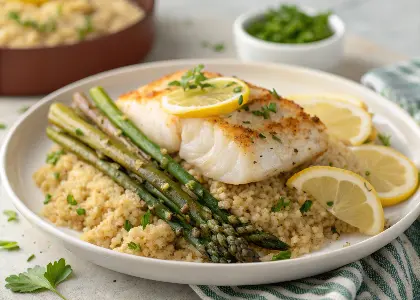
Day 6
Breakfast:
- Omelette with Spinach and Mushrooms: Make an omelette with eggs, spinach, and sautéed mushrooms. (2 eggs, 1 cup spinach, 1/2 cup sautéed mushrooms)
Lunch:
- Tuna Salad: Combine tuna with mixed greens, cherry tomatoes, cucumber, and a lemon vinaigrette. (1 can tuna, 2 cups mixed greens, 1/2 cup cherry tomatoes, 1/2 cup cucumber slices, 1 tbsp lemon vinaigrette)
Dinner:
- Baked Cod with Brown Rice: Serve baked cod with brown rice and roasted asparagus. (6 oz baked cod, 1/2 cup brown rice, 1 cup of asparagus)
Snacks:
- Apple Slices with Almond Butter: Spread almond butter on fresh apple slices. (1 apple, 2 tbsp almond butter)
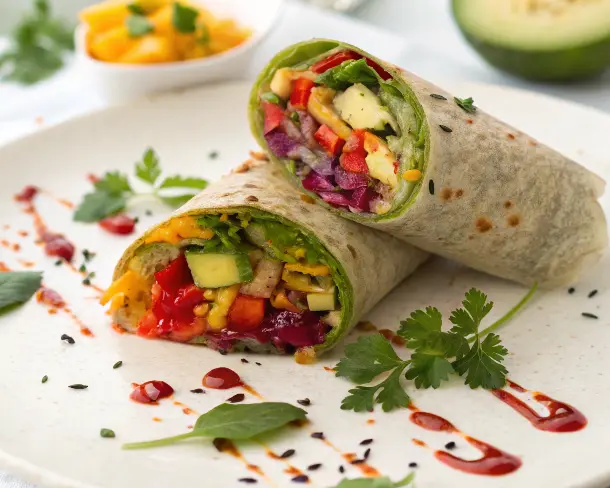
Day 7
Breakfast:
- Chia Pudding: Mix chia seeds with almond milk and top with fresh berries. (1/4 cup chia seeds, 1 cup almond milk, 1/2 cup fresh berries)
Lunch:
- Grilled Veggie Wrap: Wrap grilled vegetables like zucchini, eggplant, and bell peppers in a whole grain tortilla with hummus. (1/2 cup grilled zucchini, 1/2 cup grilled eggplant, 1/2 cup grilled bell peppers, 1 whole grain tortilla, 2 tbsp hummus)
Dinner:
- Turkey Meatballs with Zoodles: Serve baked turkey meatballs with zucchini noodles and marinara sauce. (4 oz ground turkey, 1 cup zucchini noodles, 1/2 cup marinara sauce)
Snacks:
- Trail Mix: A mix of nuts, seeds, and dried fruit. (1/4 cup trail mix)
Benefits of Clean Eating
Embracing clean eating can lead to a variety of health benefits:
- Weight Management: Clean eating helps regulate your weight by focusing on natural, low-calorie foods that keep you full and satisfied.
- Increased Energy Levels: Clean foods provide steady energy, reducing the likelihood of energy crashes that often come with consuming refined sugars and processed foods.
- Better Digestion: A diet rich in fiber from fruits, vegetables, and whole grains supports healthy digestion and can prevent issues like constipation.
- Improved Mental Clarity: Many people report clearer thinking and better focus when following a clean eating diet, possibly due to the elimination of additives and preservatives.
- Enhanced Immune System: Nutrient-dense foods rich in vitamins, minerals, and antioxidants strengthen your immune system, helping your body fend off illnesses more effectively.
- Clearer skin: A clean eating diet rich in fruits, vegetables, and water supports skin health, reducing inflammation and breakouts.
- Better sleep quality: Nutrient-rich foods help balance hormones and neurotransmitters, leading to more restful and consistent sleep.
How to Eat Clean for Beginners
Starting a clean eating diet is one thing, but making it a lasting lifestyle requires a few strategies:
- Start Gradually: Don’t try to overhaul your entire diet overnight. Begin by making small changes, like swapping out processed snacks for whole fruits or vegetables.
- Focus on Whole Foods: Fill your plate with fruits, vegetables, whole grains, and lean proteins.
- Plan Your Meals: Take the time to plan your meals for the week, making a shopping list that focuses on whole foods.
- Cook at Home: Preparing your meals allows you to control the ingredients, making it easier to eat clean.
- Read Labels: Get in the habit of reading ingredient lists to avoid hidden sugars, artificial additives, and unhealthy fats.
- Stay Hydrated: Drinking plenty of water is key to staying energized and aiding digestion. Herbal teas and infused water can add variety.
- Find Clean Eating Alternatives: If you crave something sweet or savory, look for clean alternatives that satisfy without compromising your eating habits.
- Allow Flexibility: Remember, clean eating is about balance, not perfection. It’s okay to indulge occasionally as long as it doesn’t become a habit.
Conclusion
Following a clean eating diet can be an excellent way to reset your eating habits and start on a path towards better health.
Remember, clean eating is not about perfection, but about making better choices most of the time.
Over time, these choices will become habits, and clean eating will be a natural part of your everyday routine.
Be patient with yourself, enjoy the process of discovering new foods and recipes, and most importantly, listen to your body.
- Military diet plan 7 days
- Endomorph diet plan for women
- The metabolic confusion diet
- 7-day alkaline diet for beginners
- 7-day candida diet plan with food list
- 14-day real food diet and recipes for family
- 7-day low glycemic meal plan
- Cheap and affordable Aldi meals
- Mounjaro side effects
- The ketogenic diet for beginners
- Gastric bypass diet plan
- Best diet to lower triglycerides
- 7 day anti-inflammation diet plan
- 21 day Fix meal plan for beginners
- Hashimoto’s meal prep ideas
- Blue Zone diet meals for beginners
FAQs
Can you lose weight just by clean eating?
Yes, many people can lose weight by adopting a clean eating lifestyle. Clean eating focuses on whole, nutrient-dense foods and eliminates processed items, which can naturally lead to reduced calorie intake and weight loss.
However, portion control and regular physical activity are also important factors in weight management.
Is pasta clean eating?
Whole grain pasta can be part of a clean eating diet. Look for pasta made from 100% whole wheat or other whole grains. Refined white pasta is generally not considered clean eating due to its processing.
Are eggs considered clean eating?
Yes, eggs are considered a clean eating food. They’re a whole food rich in protein and nutrients. Opt for free-range or organic eggs when possible.
Is bread clean eating?
Whole grain bread can be part of a clean eating diet. Choose breads made with 100% whole grains and minimal added ingredients. Avoid highly processed white breads.
How to eat 100% clean?
Eating 100% clean involves consuming only whole, unprocessed foods. This means preparing all meals from scratch using fresh ingredients, avoiding all packaged and processed foods, and eliminating added sugars and artificial additives from your diet.
Are potatoes clean eating?
Yes, potatoes can be part of a clean eating diet. They’re a whole food and a good source of nutrients. The key is in the preparation, baked or roasted potatoes are healthier choices than fried options.
What are the 15 clean foods?
While there’s no definitive list, 15 commonly cited “clean” foods include:
Leafy greens, berries, nuts, seeds, avocados, eggs, salmon, quinoa, sweet potatoes, Greek yogurt, lentils, olive oil, green tea, apples, and broccoli.
